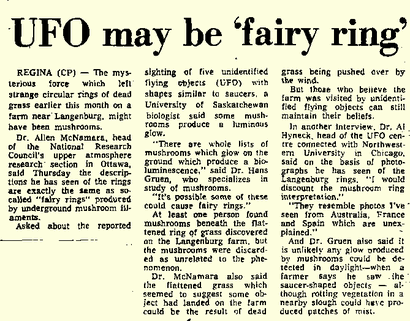|
We are fortunate to have a number of photographs of these rings, as shown above.
The rings are all swirled clockwise, and are very close together, almost touching. The main set of five were estimated as between 10 and 12 feet in diameter (around 3 to 4 metres), with the sixth somewhat smaller at around 6 feet (2 metres). There was a good deal of media interest in this case, and in an effort to rubbish the story, Dr Allen MacNamara of the National Research Council claimed the circles were made by fungus. This was disputed by J Allen Hynek as implausible. What to make of Fuhr's story? We have no view, but readers can judge for themselves whether the mushroom theory is consistent with the photographic evidence and the fact that the rings were positioned relative to each other. |
This case is of particular interest because the rings not only sat in formation, rather than being placed more-or-less randomly about the field, but also because of the revisitation by whatever caused them. Revisitations are rare, and it will be noted that here, a sixth marking was created, which was also in formation with the pre-existing rings, as if by design.
Shown below is an approximate sketch of the final layout, based on the information available. (There are no long shots of the site as far as we are aware.) Also shown is Edwin Fuhr's own sketch of the metallic domes he says he saw.
Shown below is an approximate sketch of the final layout, based on the information available. (There are no long shots of the site as far as we are aware.) Also shown is Edwin Fuhr's own sketch of the metallic domes he says he saw.
historic old crop circles - related cases









